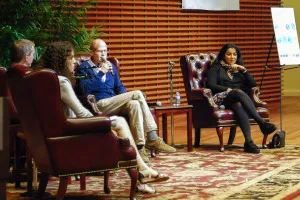
Last Friday, the Stanford Storytelling Project and the Stanford Speakers Bureau brought graphic novelists Chris Ware (“Jimmy Corrigan: The Smartest Kid on Earth”) and Marjane Satrapi (“Persepolis”) to Cemex auditorium to talk about the nature of the graphic novel, as well as their writing processes.
Ware and Satrapi have very different on-stage personalities. Ware is self-deprecating, revealing his modesty. He remarked, “I’m much more comfortable sitting at a desk and having no external forces exerted upon me at all. The whole idea of doing anything and showing it to anyone conscious is mortifying to me.” However, Satrapi is brazen, revealing how comfortable she is in her own skin. She openly admitted, “It’s really 10 percent of [all] people that I really like.”
Yet both graphic novelists are similar in their personal views about the graphic novel in relation to their own lives and life itself. When someone asked Satrapi about her style of writing, she responded, “Personally, I try to come closest to real life. The more you look for a style, the more you find death; style kills you. But if you look for life, you will find your style because style comes from sticking the closest to what life is like without trying to analyze it.” She views her career is no different than the role of an observer.

Likewise, Ware likes to write about how people relate to each other. “I’m trying to write through the consciousness of other persons, and that, to me, is really what it means to be alive. It’s about trying to empathize or develop a sense of empathy for others and try to understand what other people are feeling. To me, that seems to be the origin of language.” Ware said. For Ware, fiction helps us understand what it’s like to be someone else.
The event ended on a high note, with questions from the audience as well as important advice from Ware and Satrapi. Satrapi said, “If you do your work honestly, [and] you write and do something that you like, then success, if it comes, is better. If it doesn’t, you have the satisfaction of doing work that really pleases you.” In response, Ware urged the audience that you should be willing to sacrifice a lot for your art: “The worst thing you can do as a young artist is to aim for trying to make a living off your art. You should aim for simply setting up a way to make your art in a way that is sustained and separate because otherwise you’re looking in the wrong place.”
Contact Marty Semilla at msemilla ‘at’ stanford.edu. Learn more about the event online.
